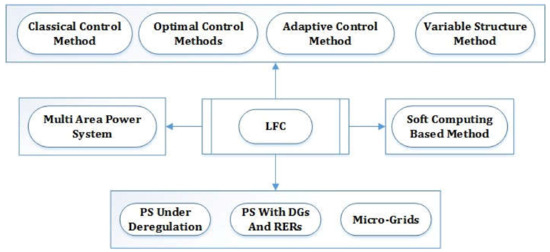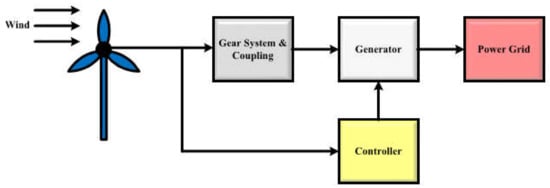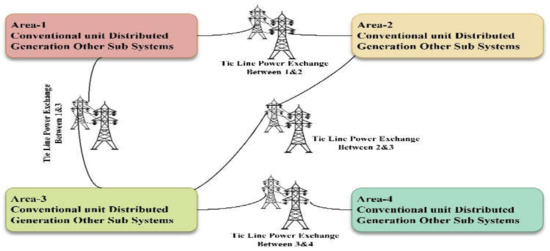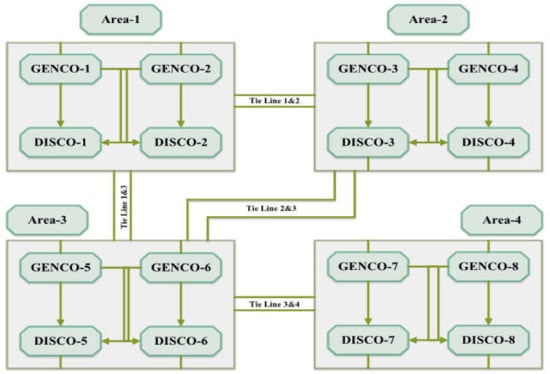1. Introduction
Power system stability is an important area of concern in modern interconnected power systems. It is termed as the capability of a power system to become stable after the removal of disturbances. While an unstable system loses its control by falling out of synchronism, this phenomenon may have a catastrophic impact on the smooth running of the power system. Stability concerns have become an integral part of the design of a reliable system; maintaining synchronism between different parts of the power system is a crucial task for power system engineers [
1]. It is necessary to generate electric power in accordance with load side demand while considering the losses as well. A stable power system operates around a specific region, different external conditions may deviate the nominal frequency of the power system to an unstable region [
2].
The frequency control in modern power systems is achieved using two control loops: one is primary, and the other is secondary [
3]. The first one is responsible for preventing the frequency transients provided using governor droop which can generate the steady state error [
4]. The second method is known as automatic gain control or load frequency control which may regulate the system frequency at a stable level. In its early days, the load frequency control was obtained using conventional PID controllers, but further research developed intelligent controllers, fuzzy controllers, Sliding Mode Controllers and Tilt Integral Derivative controllers. A modern controller design based on sliding mode control and adaptive control pattern provides a better real-time control of the power system. Further research is being carried out in the areas of Brain Emotional Learning-Based Intelligent Controllers (BELBICs) and Support Vector Machine-based controllers to improve the performance.
2. Review on Load Frequency Control Considering Renewable Energy Sources
There are several power system configurations in renewable energy systems, but in this research, these are classified as single-area power systems and multi-area power systems. The former is an isolated power system, while the latter is usually a tied power system. The environmental non-linearity disturbs the normal operation of the power system, the interconnection of renewable energy systems develops transients and frequency deviations [
34]. The introduction of modern power generation, transmission and distribution techniques makes the power system operation complex. The power quality tackling in complex power system research and development is being carried out in the field of Load Frequency Controllers. Various control strategies and optimization algorithms have been suggested for the improvement of power quality and response of the system to the abnormalities [
35]. The employment of LFC in various areas along with optimization techniques is shown in
Figure 2. Different algorithms are used for LFC optimization in order to improve the transient response and settling time.
Figure 2. LFC in Different Environments.
Different control methods in LFC development include classical control, optimal control, adaptive control, variable structure control and robust control. The restructuring of rules and regulations imposed by the government introduced deregulations in the power system. These days, electricity is traded as a commodity, creating the issue of transmission congestion. The multi-area deregulated systems create the issues of transmission congestion focusing on the need of sophisticated LFC structures. With more people installing renewable energy systems at home, the concept of distributed generation is getting more attention. The power generated at different isolated locations creates power quality issues which can be addressed using a better-designed LFC. From a configuration point of view, the power system can be categorized as a single-area power system and multi-area power system.
Different soft computing approaches are used for the intelligent tuning of LFC controllers in modern power systems [
36]. For islanded microgrids, a FOFPID controller has been developed using the multi-objective extremal optimization method [
37]. The Flower Pollination algorithm was used for the optimization of the PI-PD cascade controller in regulating the AGC in multi-area power systems [
38]. The iterative proportional-integral-derivative H∞ controller was developed to iteratively stabilize the power system transients in a hybrid environment [
39]. The biogeography-based optimized three-degrees-of-freedom integral-derivative controller has been developed for the load frequency control of a hydrothermal system under a deregulated environment [
40]. The modified multi-objective genetic algorithm was used for the development of a framework for economic load frequency control in hybrid power systems [
41]. In this case, the power system quality is maintained from an economical point of view and to meet the customer requirements.
The hybrid differential evolution particle swarm optimization was used for the development of a fuzzy proportional-integral derivative controller [
42]. This controller targets the automatic generation control of interconnected power systems, hence the transients produced in one system avoid reaching the other system. The particle swarm optimization and ANFIS techniques combined together for the tuning of a PID controller [
43]. The settling time and peak overshoot parameters are significantly controlled. The particle swarm optimization was used for fractional order control and simulation of wind-biomass isolated hybrid power systems [
44]. The developed system maintains the power quality and delivers the required amount of power in a specified amount of time. The interconnection of two or more systems creates the issue of non-linearity, hence the cuckoo search algorithm-based Load Frequency Controller design for nonlinear interconnected power systems [
45]. The steady state is reached in minimal time, and the transient response of the system improves as well. To further improve the load frequency control, a modified form of the cuckoo search algorithm known as the non-dominated cuckoo search algorithm was applied for the tuning of LFC [
46]. The non-dominated cuckoo search algorithm-optimized controller improves the frequency regulation characteristics of the wind thermal power system. To target the frequency response of hybrid power systems, an effective hybrid harmony search and cuckoo optimization algorithm-based fuzzy PID controller used for load frequency control [
47].
The nonlinearities always posed operational issues in LFC development; hence, the bacterial foraging optimization algorithm-based design of PID controller has been implemented for two-area load frequency control [
48]. The BFOA algorithm is further combined with the particle swarm optimization algorithm for multi-objective load frequency control in hybrid power systems [
49]. For the intelligent tuning of LFC, neural-network-based integral sliding mode control was developed for nonlinear power systems with wind turbines [
50]. The neuro-fuzzy hybrid intelligent PI control approach was adopted in four-area load frequency control of an interconnected power system [
51]. Deep learning techniques was used for data forgery detection in automatic generation control [
52]. Predictive control was used for real-time frequency regulation and rotational inertia provision in power systems [
53]. To further improve the intelligent control techniques, supervisory predictive control of power system was developed [
54]. The model predictive control was developed for power system frequency control taking into account imbalance uncertainty [
55]. It provided better state estimations and resulted in more sophisticated control of power system networks.
The distributed model predictive control was developed for load frequency control with dynamic fuzzy valve position modeling for a hydrothermal power system [
56,
57]. It improved the overall transient and steady state response of the power system. The hybrid differential evolution-grey wolf optimization algorithm was applied to the automatic generation control of a multi-source interconnected power system using an optimal fuzzy PID controller. The cascaded design of a PD-fuzzy-PID controller was optimized using fuzzy logic techniques [
58].
2.1. Single-Area Power System
A single-area power system contains only one renewable energy source which can be wind, solar, biomass, hydel or tidal. It is a simple system where power generation and utilization are easy. A wind turbine-based single-area power system is shown in Figure 3. Here, the feedback loop contains a controller which tracks the output signal and adjusts the parameters of the system to maintain output power quality.
Figure 3. Wind Turbine-Based Single-Area Power System.
LFC’s design for a single-area power system has been improved with the passage of time to lower the settling time, overshoot and undershoot in the output signal. In modern power systems consisting of a number of generation sources, the disturbance imposes on the power system variables developing errors in system operation. The development of a disturbance rejection procedure is the need of time. In [
59], the Microgrid System presented by Qi et al. uses an improved linear active disturbance rejection control algorithm (ILADRC) for tuning the PID controller. The results suggested a superior performance than LADRC, Fuzzy PI and conventional PI controllers. The power system is tested under different test conditions and each scenario showed a remarkable improvement in power system operation.
In [
60], worked on the tuning of PID controllers using the Mine Blast Algorithm (MBA) showing remarkable improvements in settling times and peak overshoot values. Integrating a superconducting magnetic energy storage system enhances the convergence of signals in a power system, as done in [
61] by Wichan et al. Here, the bee optimization algorithm was used for system optimization providing superior performance to a conventional PID and SF-FLPID. The scaling factor fuzzy logic PID provides better control on the gains of a conventional controller.
2.2. Multi-Area Power System
Modern power systems are becoming flexible, and renewable energy sources such as wind and solar can be integrated with conventional power plants. The load frequency control is a complicated task in multi-area power systems because of the increased instability due to the interconnection of different generation sources. LFC design for a multi-area power system is based on the amount of frequency deviation in each area of control. The tie line power deviation is a serious issue in interconnected systems; it can generate transients and instability of the power system. An abrupt variation in load and power generated by renewable energy sources can cause huge instability in output power.
The tie line power exchange between various areas is shown in Figure 4, each of the areas consist of conventional units with distributed generation and connected with various sub-systems. The interconnection of different areas creates problems such as transients and harmonics. The power imbalances create the issue of power flow on the interconnected lines; hence, the frequency control involves power flow measurement on the interconnected lines. The frequency control characterizes the whole power system, and its control is crucial for reliable operation. To maintain the power system frequency at a fixed level, the total amount of active power generation must be equal to the active power consumption at any instant of time.
Figure 4. Power Exchange between Different Areas.
Figure 5 shows the Tie Line Interconnection of various GENCOs; here, the system is divided into various areas. Each area contains generation companies (GENCOs) and distribution companies (DISCOs), while the tie lines are used for interconnection purposes. Making such a configuration in terms of the number of areas improves the manageability of the power system. In each area, the power flows between the GENCO and DISCO, while tie lines allow the power flow in-between the areas. There is a bidirectional power flow in-between the areas, GENCOs and DISCOs.
Figure 5. Tie Line Interconnection of GENCO.
2.3. Multi-Stage Controllers
Single-stage controllers are easy to operate and inexpensive; different techniques have been developed for the optimization of settling time, overshoot and undershoot values. Further improvements in settling times and overshoot values have been achieved using cascading controllers. Although it makes the system a little bit complex, it provides results not achievable using simple controllers. In [
62], worked on a two-stage FPIDN-FOI controller optimized with the Imperialist Competitive (ICA) Algorithm; the settling time, overshoots and undershoots improved a lot compared to HFA-, PS- and GWO-optimized PID. In [
63], used two-stage adaptive Fuzzy PI controllers optimized with the particle swarm optimization algorithm (PSO) and grey wolf optimization algorithm (GWO). The results show a superior performance in settling time, peak overshoot and peak undershoot of a two-stage controller. In [
64], Gulzar et al. worked to develop an adaptive fuzzy-based optimized proportional-integral controller to mitigate the frequency oscillation of a multi-area photovoltaic thermal system. The results of this work are exceptional as the settling time reduced significantly.
A similar approach adopted by [
65] using an invasive weed optimization algorithm (IWO) achieved remarkable success in lowering the settling time value with a cascaded approach. To adjust the controller parameters, continuously retrieving the system performance adaptive control was developed [
66]. The two-stage topology combined with the adaptive control system provides better control of the power system on a continuous basis.
This entry is adapted from the peer-reviewed paper 10.3390/en15103488




